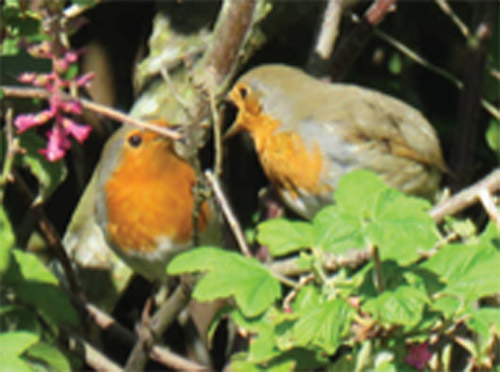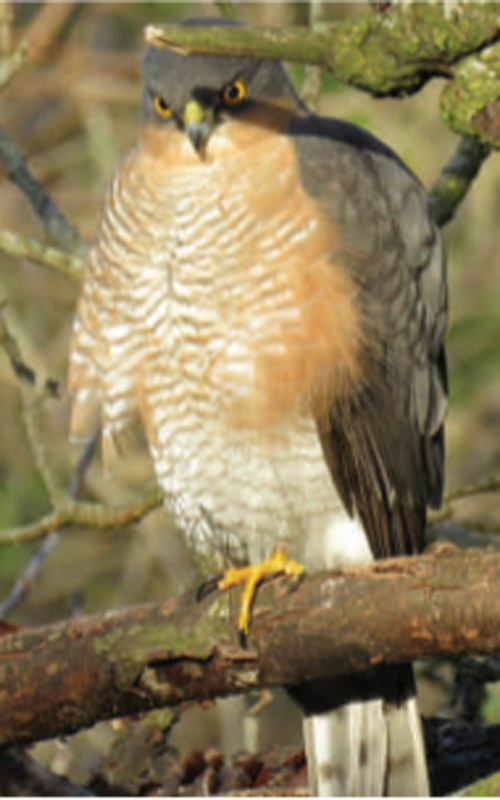| May
/ 2020 - Michael Ryan
|
|
It might seem counter intuitive to write a diary during stressful times
but expressing your thoughts and concerns back to yourself, on paper
or screen, can be therapeutic and there’s no need to hold back any opinions or feelings since you yourself are the only intended reader. But even noting the small everyday things around us can be rewarding. A lot of people have been getting comfort from nature during these difficult times, certainly helped by some glorious weather. Bird song is so much easier heard without traffic or machinery noise and people might start to notice wild flowers or insects they hadn’t previously been aware of. Even trying to identify these can spark further appreciation and growing knowledge and I’m sure nobody has ever regretted being able to correctly name something. If you’re interested in nature, keeping notes is always very worthwhile and creating records and subsequently finding them is so easy now when you can do it digitally. A quick word search on a computer can take just seconds though actually browsing through hand written tomes of your thoughts and memories from years past can be quite a revelation. I have kept ordinary day to day diaries over the years, sometimes recording thoughts and significant occurrences although the most consistent records seem to have been of the weather and happy walks with a succession of dogs. In the diaries I’d often make a short note of nature records at the top of the page, maybe the first song heard that year of a resident bird or a first migrant seen that year. |
 Male robins often feed food to a female as part of courtship Photo by Lucy Desierdo |
 The male Sparrowhawk that visited and wasn’t in any hurry to leave Photo: Michael Ryan |
The
wind was shaking the tops of the eucalyptus trees on the 5th April when
our first two swallows of this year appeared overhead, circled for a
while then moved on. Although it was my partner Lucy who spotted them
first, I’ll take credit for telling her earlier to keep an eye out for them since there was a good possibility the strong southerly winds might carry in swallows and other migrants and already that morning we’d heard and then seen a Willow Warbler, also our first of the year, flitting around the pond at the end of the garden. A few days later I was up a ladder and had just cut through an oak tree branch which was creaking just as it was about to split away and fall when Lucy came up to tell me there was a sparrowhawk perched on the other side of the hedge. I couldn’t stop the branch going and thought the noise would scare the hawk away but after it crashed to the ground the bird remained unperturbed. It was a male, they’re much smaller than the female sparrowhawk with reddish brown breast and grey back and this chap was perched on a branch right above a nyjer seed feeder, maybe hoping his food would come to him rather than him having to hunt it |
|
I’m always in two minds about sparrowhawks in the garden, it’s great to see one, they’re such a dramatic presence, while at the same time I’m always hoping they won’t catch any of my visiting birds. Or in this case, any of my resident birds since a pair of blue tits had been busy bringing nesting material to the nest box outside our kitchen. I decided I’d approach the sparrowhawk, maybe getting a few closer photos, before my presence would scare him off so I moved furtively up the garden and stood behind a bush. I couldn’t get a clear photo from there so stepped out into the open. The sparrowhawk glanced at me fairly disinterestedly and nonchalantly continued his business of staring fiercely, yawning, looking intently in every direction, left and right, above him, at the ground, twisting his head around almost 360 degrees, and scratching his face with long black tipped yellow talons. I was standing out in the open now, just 15 feet away from him, while talking to Lucy in an even louder than normal voice. I joked to her that maybe I could go up to the bird and take a selfie with him and approached even closer until, maybe concerned I was about to breach sparrowhawk social distancing compliance, he flew off, but not far, only going a little bit up the garden. I later measured the closest distance I’d got to him and it was eight feet, (less than 2.5 metres). But that wasn’t to be the closest I was to get to him The following morning I heard a high pitched continuously oscillating sound from the garden, a sound that’s described on the BirdWatch website as sounding like an ‘odd mechanical reel reminiscent of a fishing line being paid out’. I’d heard the sound before and knew it was the call of a Grasshopper Warbler, a summer migrant, probably very recently arrived, possibly the previous night. Their name is often abbreviated to ‘Gropper’ by birding folk their Latin name being Locustella Naevia, locustella meaning little grasshopper referencing their call. They’re notoriously difficult to see, usually only heard, and even then they’re very difficult to locate as they turn their head around as they sing, throwing the sound around and creating a ventriloquist effect. They never stay around our garden for longer than a day, maybe taking a rest and feeding before moving to more suitable habitat such as rough farmland, the edge of bogs, elevated ground or at the edges of conifer plantations. They’re widespread summer visitors but not common anywhere in the country. I told Lucy there was one in the garden and asked her to bring out her phone to record it which she did. |
 Soon to be probably our most common bird of prey, the buzzard, this one over the quarry Photo: Michael Ryan |
|||
 Grasshopper Warbler, a very elusive little bird that’s arrived in the garden more than once Photo: Michael Ryan |
She played back the recording which made the bird approach nearer us, thinking its own song was a rival male and giving me my first ever half decent view of this species when Lucy spotted it deep within a tangle of branches low down in a forsythia bush. It began calling again and I was able to get some grainy photos of it. It flew further down the garden into a cluster of dead branches on the ground and we were trying to spot him when suddenly a flash of grey shot past my face, inches away, before twisting right and darting away. We just looked at each other, speechless and bemused. It was the sparrowhawk again, thankfully not catching our little visitor or any other bird. He’d flown in low around a bush then past us towards the feeders through a gap between me and a bush not wider than an outstretched arm. That Grasshopper Warbler, wasn’t the first one that had visited the garden, I’d heard them before in years past so I did a search of nature records on my computer and found I’d had one calling in the garden on 12th April 2014. I knew I’d had at least two singing in the garden prior to that so I looked back through hand written diaries from Aprils of earlier years. Although it wasn’t about a bird an entry from back in April 2004 caught my eye as it had an exclamation mark after which was to note my excitement at seeing five red squirrels together on Killiney Hill, almost certainly a family, on a silver birch near the path coming down from the obelisk. The most red squirrels I’d ever seen together, a beautiful and charming sight but in retrospect very sad because it was the following year, 2005, that the first year grey squirrels arrived in the park on Killiney Hill and ultimately the reds would disappear completely, none having been seen on the hill for approaching two years now. I can still remember my excitement at that sighting but without the diary wouldn’t have had a clue when it happened. But it was on the following day’s entry I found a note of hearing the ‘Gropper, not in the garden but in the slopes between the Vico and the Dart line when I was taking the dogs to the beach. That date was 9th April 2005 and now, fifteen years later, I’d had one in the garden on the exact same date, the 9th April. Like the swallows and willow warbler these birds might have been carried in on a southerly wind then settled briefly in our garden on the sheltered side of the hill where, out of the strong breeze, there would be more insects to feed on. But the fact I found quite extraordinary was that Grasshopper Warblers that fly from wintering grounds in Senegal crossing the Sahara and the Mediterranean have, on three different occasions over 16 years, arrived in Dalkey on almost the same day of the month. And if it wasn’t for keeping notes, I’d never have known that! |
|||
Images & Text by :- Michael Ryan
DALKEY HOME PAGE | DALKEY COMMUNITY COUNCIL | DALKEY HERITAGE COMPANY | CANNONAID
|
|


